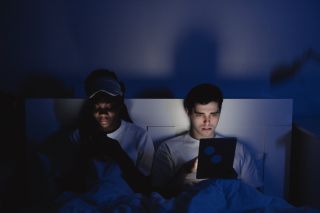Sleep
Blue Light May Not Be Keeping You Awake After All
A new study shows that the brightness of light matters more than its color.
Posted December 31, 2023 Reviewed by Gary Drevitch
Key points
- Researchers exposed healthy subjects to blue, yellow, and white light for an hour before bed.
- The color of light made no difference to participants' level of drowsiness or sleep quality.
- Light-sensitive ganglion cells in the eye, not color-producing cone cells, affect circadian rhythm.

If you put a blue light filter on your phone in the evenings to wind down before sleep, it might not be helping as much as you think.
Most smartphones, tablets, and other devices offer night settings that change the color temperature of the light they emit over the course of the day, from cool blue tones while the sun is up to warmer yellow tones after dark. This function is a response to research suggesting that exposure to blue light in the evenings can negatively affect sleep quality by disrupting the brain’s circadian rhythm, the internal clock that regulates our sleep-wake cycle.
But a new study from the University of Basel and the Technical University of Munich has shown that the color of light may not have as much of an impact on sleep as previously believed.
The Anatomy of Vision
There are three types of photoreceptors (cells that detect light) in the human eye: rods, cones, and light-sensitive ganglion cells (ipRGCs).
Rods and cones contribute to vision by transforming light into electrical impulses that are relayed to the brain’s visual cortex. Cone cells activate in bright light conditions and come in three subtypes that respond to different wavelengths of light: short, medium, and long. The brain converts the signals from short-wavelength cones into the color blue, medium-wavelength cones into green, and long-wavelength cones into red.
Rod cells only activate in low-light conditions and aren’t sensitive to different wavelengths of light, so the brain translates their signals into shades of gray. This is why we can’t make out colors in dim light.
Light-sensitive ganglion cells, on the other hand, don’t play a role in visual perception. Instead, they provide information to the brain on light intensity. They not only help adjust pupil dilation to match ambient light conditions, but also synchronize our circadian rhythms by indicating to the brain when it’s daytime.
In addition to detecting light on their own, light-sensitive ganglion cells receive input from cone cells, which means they could be affected by the perceived color of light.
Is Blue Light Bad Before Bed?
To determine whether blue light exposure worsens sleep, researchers exposed 16 healthy subjects to three different light conditions for one hour before bedtime: a blue-toned light, a yellow-toned light, and a white light as a control.
The lights were designed in such a way that they would activate different cone cells but stimulate light-sensitive ganglion cells equally. Any difference in participants’ sleep cycles could then be directly linked to the color information processed by the cones.
To achieve these precise physiological conditions, the researchers manipulated the intensity of each hue of light. Light-sensitive ganglion cells are most responsive to short-wavelength light, so, to even out the cells’ reactions, the yellow-toned light was brighter (123.5 lux, similar to the average family room) and the blue-toned light dimmer (67.0 lux, something like bedroom mood lighting).
After the light exposure, researchers took various measures of each subject’s drowsiness and sleep quality – testing their reaction times, tracking how long it took them to fall asleep, and assessing the depth of their sleep at the beginning of the night. Researchers also asked each participant how sleepy they felt, from a subjective point of view.
In the end, the three different lighting conditions had no effect on participants’ sleep.
“We found no evidence that the variation of light color along a blue-yellow dimension plays a relevant role for the human internal clock or sleep,” says Christine Blume, lead study author and post-doctoral researcher at the University of Basel’s Centre for Chronobiology. “Rather, our results support the findings of many other studies that the light-sensitive ganglion cells are most important for the human internal clock.”
The study suggests that what matters is the brightness of light relative to its wavelength. The color you perceive is irrelevant.
So does that mean the Night Shift function on your phone is useless?
Though another study has shown that warm-light screen settings don’t actually improve sleep quality, Blume says we shouldn’t do away with them just yet. Most night options on electronic devices change not only the color temperature of the light they emit but also its intensity, which does have an impact on sleep.
"Technologically, it is possible to reduce the short-wavelength proportions even without color adjustment of the display; however this has not yet been implemented in commercial mobile phone displays," she says.
But for the very best sleep quality, Blume advises, put your phone away well before bedtime.




